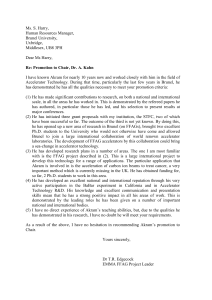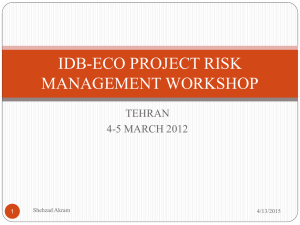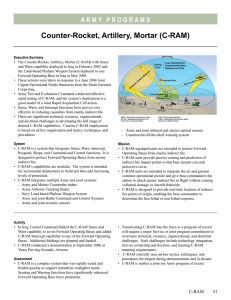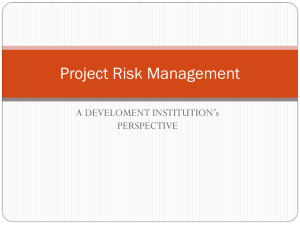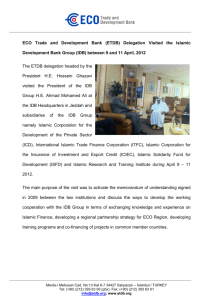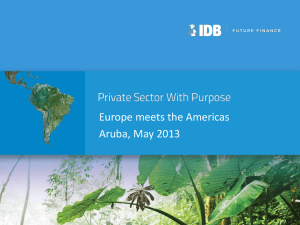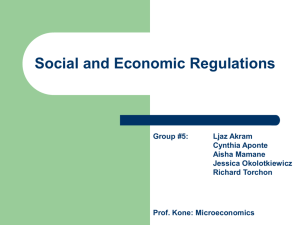Promotion of Islamic Financial Institutions in Africa
advertisement
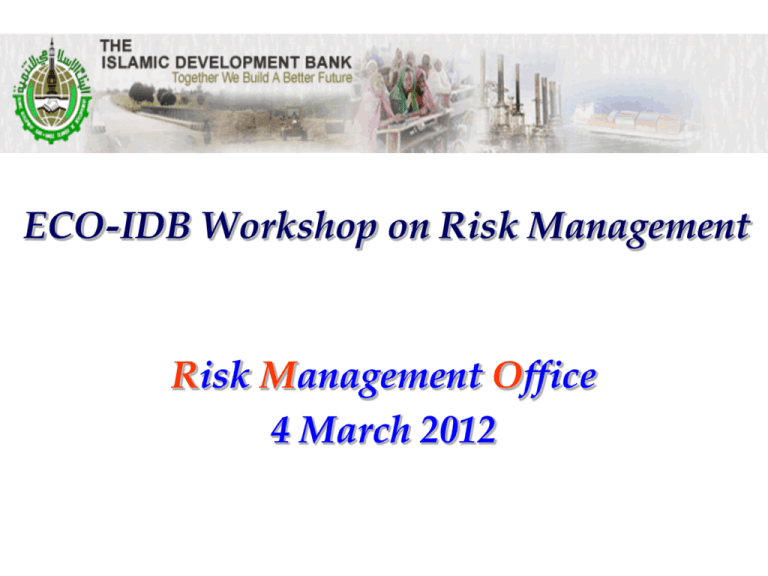
ECO-IDB Workshop on Risk Management Risk Management Office 4 March 2012 Agenda The Concept of Risk Management Risk Management Governance in IDB Overview on the Risk Management Office (RMO) Financial Reporting System developed by RMO Risk Management Function in IDB Main Risk Management Guidelines developed by RMO Shehzad Akram 2 The Concept of Risk Management • Risk arises when there is a possibility of more than one outcome and the ultimate outcome is unknown. • Banking risks refer to the potentials that bank’s financial position or performance will be subject to unfavorable impact of factors affecting its business. • Risk management in financial institutions involves the: – Identification, – Measurement, – Control, – Monitoring of all types of risks inherent in its activities Shehzad Akram 3 Risk Management Governance in IDB The Board of Governors The Board of Executive Directors The Audit Committee to the BED Operations Committee Assets Management Committee Risk Management Committee Trade & Investment Committee Risk Management Office (IDB Group) Shehzad Akram 4 Risk Management Office (RMO) • Established in 1421H as an independent unit reporting to H.E. the Vice President (CRS) • Effective from 06.1422H, upgraded and renamed as Risk Management and Control Office • Effective from 09.1425H, renamed as “Risk Management Office” reporting to H.E. the President, IDB. • Currently employs one Director, five Professionals, four Young Professionals, one assistant, and one secretary. Shehzad Akram 5 Organization Structure of RMO The President Risk Management Committee The Head Risk Management Office Administrative Unit Financing Operations Portfolio Section Shehzad Akram Treasury Liquidity Portfolio Section 6 Mission Statement of RMO Achieving a sound, safe and sustainable low risk profile IDENTIFICATION MEASUREMENT MONITORING All types of risks inherent in activities CONTROL Without Jeopardizing the goals and objectives of the Group Shehzad Akram 7 Major Risks Facing IDB MAJOR RISKS CREDIT RISK - Sovereign - Bank - Corporate - Project - Equity Investments Shehzad Akram LIQUIDITY & MARKET RISK - Liquidity - Mark Up - Foreign Exchange - Equity Investments - Commodity OPERATIONAL RISK - Internal Process - Systems - People - External Factors 8 Risk Management Strategy of RMO Five Pillars Reporting Risk Management Culture Risk Management Information System Risk Control & Monitoring Function Development of Risk Management Policies and Guidelines Shehzad Akram 9 Financial Reporting System - IDB - Financed Operations - Committed Not Yet Disbursed - Placement of Liquid Funds EXPOSURE LC ’s B RA ANK NT S EE / S/ DISBURSEMENT S RT PO RE APPROVALS GU A Accuracy Standardization Flexibility Presentable Convenience N IO PT CE EX - OW FL NS SH TIO CA JEC O PR - Daily - Quarterly - Monthly - By Currency - Assumptions REPAYMENTS DUES FIN AN AS CIA SE L S MA TS L TAT NA IAB EM GE IL ENT ME ITIE S + NT S VERY STRONG DATABASE - On Actual Figures SPECIAL TAILORED REPORTS Shehzad Akram 10 Main Functions & Objectives of RMO • Recommend to the Management on the overall risk management principles, policies, strategies and governance. • Define and develop risk management guidelines and procedures. • Undertake country risk assessment and propose exposure limits for member and non-member countries. • Evaluate risks and propose exposure limits for banks for financing and investments operations and placement of liquid funds. Review risks, exposure limits, and security packages for financing operations secured by alternatives to sovereign/bank guarantees. • Oversee and monitor implementation of the risk management policies and guidelines and identify deviations and propose corrective actions. Shehzad Akram 11 Main Functions & Objectives RMO • Suggest ways and means to enhance the risk awareness and risk management culture within the IDB Group. • Develop and adopt risk management systems that provide timely information on the risk exposures of the IDB Group. • Be the focal point with the Rating Agencies and ensure maintaining the highest possible ratings. • Prepare regular report on risk management related issues • Define and develop methods and systems to optimize the “risk – return” trade-offs for financing and investment operations. Shehzad Akram 12 Main Risk Management Guidelines developed by RMO • Guidelines for Country Risk Assessment • Guidelines for Evaluating Banks for the Acceptance of Guarantees and for Placement of Liquid Funds • Guidelines for Project Finance • Guidelines for Corporate Finance & Guarantee • Guidelines for the Acceptance of Assignment of Receivables • Best Business Practices and Customer Due Diligence Standards Shehzad Akram 13 Guidelines for Country Risk Assessment • Risk classification of member and non-member countries into seven risk categories (A - G) • Risk rating model based on: – – – – – Macro-economic performance Debt profile Sovereign ratings Repayment performance & Overdues Contribution to IDB Capital • Exposure limits based on risk categorization: – As a percentage of IDB capital • Country risk assessment reports and monitoring Shehzad Akram 14 Guidelines for Evaluating Banks • Risk classification of banks into seven risk categories (A - G) • Risk rating model based on CAMEL: – – – – – Capital Adequacy Asset Quality Management Earnings Liquidity • Exposure limits based on risk categorization: – As a percentage of IDB capital – As a percentage of bank’s capital and total assets • Concentration limits for placements of liquid funds • Monitoring Shehzad Akram 15 Guidelines for Project Finance • Risk classification of Projects into five risk categories (A - E) • Risk rating model based on assessing risks related to: – – – – – – – – – Technology, construction, and operations Counterparty risk Legal Competition and Market Transaction Structure Project Financial Strength Regulatory risk Business and legal institutional development Force Majeure risk • Exposure limit based on risk categorization: – As a percentage of project total cost – Absolute amount Shehzad Akram 16 Guidelines for Corporate Finance • Risk classification of Corporates into seven risk categories • (A - G) Risk rating model based on assessing risks related to: – – – – – – – – – Financial Profile Financial Trends Financial Projections Industry/ Market Position Credit Experience and Ratings Management Disclosure & Financial Reporting Country Risk Corporate Governance • Exposure limit based on risk categorization: – As a percentage of company’s equity – As a percentage of IDB’s equity Shehzad Akram 17 Guidelines for the Acceptance of Assignment of Receivables • Scope of Application: – Corporate Finance - Project Finance – Specific Asset Financing - Real Estate Asset Financing • Eligibility Criteria • Structure & Major Features – Escrow Account Arrangement • Risk Analysis – – – – Country Risk Counterparty Risk Bankruptcy Risk Currency Risk - Market/Industry Risk - Commodity Risk - Cash-Flows Risk • Security Enhancements • Monitoring Shehzad Akram 18 Best Business Practices and Customer Due Diligence Standards • Aims to ensure that the financing made available by IDB, be strictly used only for the purpose it is provided • Takes account of recommendations of international entities on: – Money Laundering – Terrorist Financing • Procedures applicable to: – – – – – Procurement of goods and services Disbursement of funds and dealing with counterparties Accepting any new customer Selecting and accepting consultants Dealing with agent banks. Shehzad Akram 19 Thank You Shehzad Akram 20
